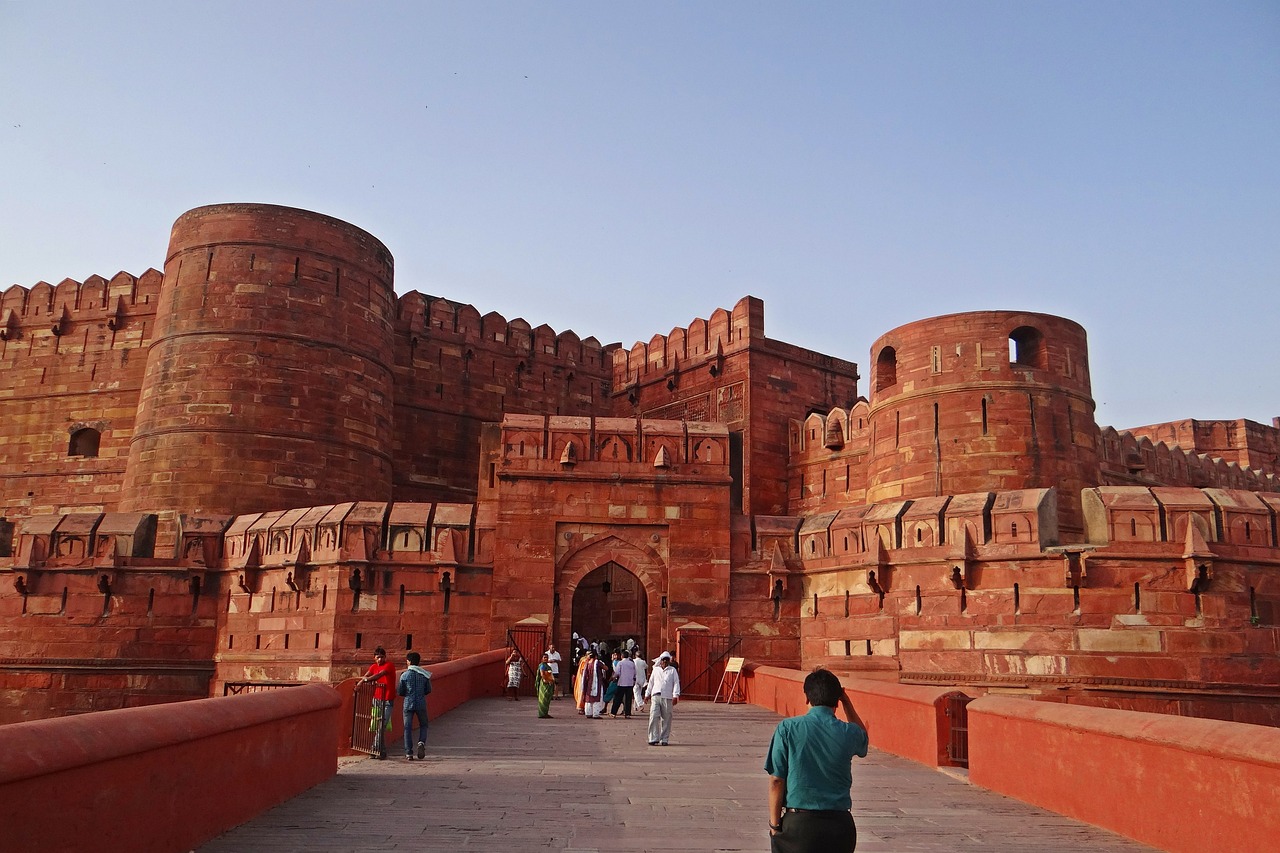Discover the Beauty of Agra: A Timeless Journey Through the City of Love

Agra is a city that holds a special place in India’s heart. Known mainly for the Taj Mahal, it’s a vibrant destination full of history, culture, and stunning architecture. Situated along the banks of the Yamuna River, Agra is part of the Golden Triangle tourist circuit, which includes Delhi and Jaipur. This blog will take you on an exciting journey through Agra, exploring its most important attractions and what makes it a must-visit destination.
The Taj Mahal: An Eternal Symbol of Love
Introduction to the Taj Mahal
The Taj Mahal is arguably the most famous monument in India and one of the Seven Wonders of the World. Built by Mughal Emperor Shah Jahan in memory of his beloved wife, Mumtaz Mahal, the Taj Mahal is a stunning mausoleum made of white marble. Construction began in 1632 and took about 22 years to complete.
Exploring the Taj Mahal
As you approach the Taj Mahal, the first thing you notice is its breathtaking beauty. The gleaming white marble dome rises majestically against the blue sky. The gardens surrounding the Taj, with their perfectly manicured lawns and reflecting pools, enhance its beauty.
When you enter the complex, you will walk through a grand gateway that frames a stunning view of the Taj Mahal. The intricate carvings and inlay work, featuring semi-precious stones, are truly remarkable. Inside, the tombs of Shah Jahan and Mumtaz Mahal are adorned with delicate lattice screens, allowing soft light to filter through.
Visiting Tips: The best times to visit the Taj Mahal are early in the morning at sunrise or late in the afternoon at sunset. The light during these times adds to the beauty of the monument and makes for great photographs. Plus, the crowds are usually smaller during these hours.
Historical Significance
The Taj Mahal is not just a beautiful building; it also represents a poignant love story. Shah Jahan built this magnificent structure to honor his wife, who died during childbirth. It is a symbol of love, devotion, and loss, attracting millions of visitors each year who come to witness its beauty.
Agra Fort: A Glimpse into Mughal History
Introduction to Agra Fort
Just a few kilometers from the Taj Mahal lies the impressive Agra Fort. This UNESCO World Heritage Site was built by Emperor Akbar in 1565 and served as the main residence of the Mughal emperors until 1638.
Exploring Agra Fort
As you enter Agra Fort, you’ll be greeted by massive red sandstone walls that stretch over 2.5 kilometers. The fort is a blend of military and Mughal architecture, featuring a series of palaces, courtyards, and gardens.
- Jahangir Palace: This beautiful palace is a perfect example of Mughal architecture. It features intricately designed courtyards and is said to be the place where Akbar's son, Jahangir, was born.
- Khas Mahal: A beautiful white marble palace that once served as a private residence for the emperors.
- Diwan-i-Khas: The Hall of Private Audience, where the emperor would meet with important guests.
One of the most breathtaking views from the fort is of the Taj Mahal. Standing on the fort’s ramparts, you can see the Taj Mahal in the distance, a sight that reminds you of the love story that created it.
Historical Importance
Agra Fort has a rich history. It was here that Shah Jahan was imprisoned by his son, Aurangzeb, who overthrew him. For eight years, Shah Jahan lived in Agra Fort, gazing at the Taj Mahal from his cell, yearning for his beloved wife. This poignant history adds depth to your visit.
Itimad-ud-Daulah: The Baby Taj
Introduction to Itimad-ud-Daulah
The Itimad-ud-Daulah mausoleum, often referred to as the “Baby Taj,” is another beautiful site in Agra. Built by Empress Nur Jahan in memory of her father, Mirza Ghiyas Beg, it is a stunning example of Mughal architecture and artistry.
Exploring Itimad-ud-Daulah
The Itimad-ud-Daulah tomb is smaller than the Taj Mahal, but its beauty is equally striking. Constructed of white marble and adorned with intricate inlay work using semi-precious stones, this mausoleum is a feast for the eyes.
The gardens surrounding the tomb are serene and provide a peaceful escape from the busyness of the city. As you walk through the gardens, take a moment to appreciate the craftsmanship that went into creating this lovely structure.
Unique Features
What sets Itimad-ud-Daulah apart is its exquisite detail. The inlay work is delicate and intricate, and the overall design is often considered a precursor to the Taj Mahal. It’s a lovely spot for photography, especially in the early morning light when the tomb sparkles like a jewel.
Mehtab Bagh: The Moonlight Garden
Introduction to Mehtab Bagh
Directly across the Yamuna River from the Taj Mahal is Mehtab Bagh, a beautiful garden that offers one of the best views of the Taj Mahal. The garden was designed as part of Shah Jahan’s vision of a grand complex that included the Taj Mahal.
Exploring Mehtab Bagh
Mehtab Bagh is a perfect place to relax and take in the stunning views of the Taj Mahal. The garden features a symmetrical layout, with pathways and fountains that create a serene environment. It’s an excellent spot for a leisurely walk or a picnic.
The best time to visit Mehtab Bagh is during sunset when the golden hues of the setting sun cast a warm glow on the Taj Mahal. This magical view is one of the most photographed scenes in Agra.
Photography Opportunities
For photographers, Mehtab Bagh provides an amazing backdrop for capturing the beauty of the Taj Mahal. The reflections of the monument in the water add an artistic touch to your photos. Don’t forget your camera!
Fatehpur Sikri: The Abandoned City
Introduction to Fatehpur Sikri
Located about 40 kilometers from Agra is Fatehpur Sikri, another UNESCO World Heritage Site. This city was built by Emperor Akbar in the late 16th century and served as the Mughal capital for a brief period before being abandoned due to water shortages.
Exploring Fatehpur Sikri
As you enter Fatehpur Sikri, you are welcomed by the impressive Buland Darwaza, the largest brick gateway in the world. This grand entrance leads you into a complex filled with stunning palaces, mosques, and gardens.
- Jama Masjid: One of the largest mosques in India, known for its impressive architecture and beautiful courtyard.
- Panch Mahal: A five-story palace offering a panoramic view of the surrounding area.
- Tomb of Salim Chishti: A beautiful white marble tomb dedicated to the Sufi saint Salim Chishti, who was revered by Akbar.
Historical Significance
Fatehpur Sikri was an important cultural and political center during the Mughal era. Akbar built this city to reflect his vision of a harmonious society, combining elements from various cultures and religions. However, due to its abandonment, the site remains remarkably well-preserved, allowing visitors to step back in time.
Local Culture and Cuisine
Experiencing Agra’s Culture
Agra is not just about monuments; it’s also a city rich in culture and traditions. The local markets, like Sadar Bazaar, are bustling with life. Here, you can find handicrafts, leather goods, and souvenirs to take home. The vibrant atmosphere, filled with the sounds of vendors and shoppers, gives you a taste of daily life in Agra.
Delicious Agra Cuisine
No visit to Agra is complete without sampling its delicious cuisine. The city is known for several culinary delights, including:
- Petha: A sweet made from ash gourd, often flavored with different ingredients like rose or saffron.
- Biryani: A fragrant rice dish cooked with marinated meat and spices.
- Tandoori Chicken: Marinated chicken cooked in a traditional clay oven, resulting in smoky flavors.
- Chaat: A popular street food that includes a variety of savory snacks, often topped with yogurt, chutney, and spices.
Visiting local eateries and street food stalls is a great way to experience Agra’s culinary scene. Don’t hesitate to try new dishes!
Cultural Performances
If you have the chance, attend a traditional performance of Kathak, a classical dance form that narrates stories through graceful movements. Local music and dance performances often take place in the evenings, adding to the cultural experience of your visit.
When to Visit Agra
The best time to visit Agra is from October to March. During these months, the weather is cooler and more pleasant, making it ideal for sightseeing. You can enjoy outdoor activities without the heat, and the air is generally clearer for viewing the magnificent monuments.
Practical Tips for Travelers
Getting Around
Agra is well-connected by road and rail, making it easy to reach from major cities like Delhi and Jaipur. Within the city, you can use auto-rickshaws, taxis, or cycle rickshaws for local transportation. Walking is also a great way to explore the markets and nearby attractions.
Dress Comfortably
When visiting Agra, wear comfortable clothing and footwear, as you’ll be doing a lot of walking. Light, breathable fabrics are ideal, especially during the warmer months. If you plan to visit religious sites, be sure to dress appropriately.
-
Discover the Beauty of Agra: A Timeless Journey Through the City of Love
-
Exploring Delhi: Navigating the Vibrant Core of Indian Heritage
-
Exploring Jaisalmer: The Golden City of Rajasthan
-
Kerala Awaits: Journeying Through God's Own Paradise
-
Exploring Varanasi: The Spiritual Heart of India
-
Manali: Where Mountain Dreams Come to Life
-
Exploring Udaipur: The City of Lakes
-
Explore the Beauty of Uttarakhand: A Journey to the Land of Gods
-
Experience the Majestic Charm of Rajasthan: A Royal Journey Through the Land of Kings

